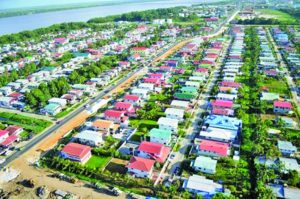As Government embarks on its massive housing drive, it is looking to utilise the acres of land owned by the Guyana Sugar Corporation (GuySuCo) that are no longer being used, as the industry is being restructured.
This was disclosed by Minister of State, Joseph Harmon at last Thursday’s post-Cabinet press briefing.
“One of the options that is available is for us to look at lands that had been used by GuySuCo that are no longer being planted with cane – for us to utilise those lands as well for housing and other forms of development,” he told reporters.
Moreover, the State Minister indicated that the Administration would also be moving to repossess those large plots of lands granted to developers under the previous Administration which have not been in use.
“Since we took office, I believe we had served notices to the owners of these lands and asked them, basically in relation to the contracts which they had, to activate the terms and conditions of those contracts. Once the time had expired and nothing was done significantly, then Government will enter into negotiations with these persons with a view of repossessing these lands for better use by the community… We believe it is not right for large plots of land to be lying idle while we are basically trying our best all-around to find lands for people,” he stated.
Harmon noted, however, that any repossession would have to be done via due process. He added too that Government has learnt that some developers, who were given large tracts of lands to develop housing estates, were actually subdividing the lands then selling them as house lots at costs that were several times the value they paid for them. This practice, the Minister said, is something that Government will be looking into as well.
Meanwhile, with Government embarking on several major housing projects, it is pushing the use of more local materials and contractors when doing construction work. Harmon told reporters that Guyana imported many foreign species of lumber when the country had a wide variety here to choose from.
“…We want to encourage the use of the woods that we have here in Guyana… There are also some proposals to relook at the production of clay bricks and many of these things which really made us self-sufficient in some way; we’ll have to review these things, because we can’t just continue buying these products from abroad when in fact we have the facilities right here to do it,” Harmon posited.
Concessions
To this end, the State Minister noted that Government would be introducing tax concessions to encourage the use of local materials. He went on to say that the thrust of the coalition Government was to not only provide house lots to Guyanese but to build houses to form communities, which would be the focus of its housing drive.













